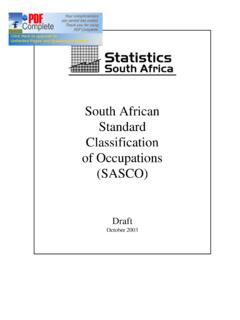Transcription of History of the development of the ICD - WHO
1 History of the development of the ICD 1. Early History Sir George Knibbs, the eminent Australian statistician, credited Fran ois Bossier de Lacroix (1706-1777), better known as Sauvages, with the first attempt to classify diseases systematically (10). Sauvages' comprehensive treatise was published under the title Nosologia methodica. A contemporary of Sauvages was the great methodologist Linnaeus (1707-1778), one of whose treatises was entitled Genera morborum. At the beginning of the 19th century, the classification of disease in most general use was one by William Cullen (1710-1790), of Edinburgh, which was published in 1785 under the title Synopsis nosologiae methodicae.
2 For all practical purposes, however, the statistical study of disease began a century earlier with the work of John Graunt on the London Bills of Mortality. The kind of classification envisaged by this pioneer is exemplified by his attempt to estimate the proportion of liveborn children who died before reaching the age of six years, no records of age at death being available. He took all deaths classed as thrush, convulsions, rickets, teeth and worms, abortives, chrysomes, infants, livergrown, and overlaid and added to them half the deaths classed as smallpox, swinepox, measles, and worms without convulsions.
3 Despite the crudity of this classification his estimate of a 36 % mortality before the age of six years appears from later evidence to have been a good one. While three centuries have contributed something to the scientific accuracy of disease classification, there are many who doubt the usefulness of attempts to compile statistics of disease, or even causes of death, because of the difficulties of classification. To these, one can quote Major Greenwood: "The scientific purist, who will wait for medical statistics until they are nosologically exact, is no wiser than Horace's rustic waiting for the river to flow away" (11).
4 Fortunately for the progress of preventive medicine, the General Register Office of England and Wales, at its inception in 1837, found in William Farr (1807-1883) - its first medical statistician - a man who not only made the best possible use of the imperfect classifications of disease available at the time, but laboured to secure better classifications and international uniformity in their use. Farr found the classification of Cullen in use in the public services of his day. It had not been revised to embody the advances of medical science, nor was it deemed by him to be satisfactory for statistical purposes.
5 In the first Annual Report of the Registrar General (12), therefore, he discussed the principles that should govern a statistical classification of disease and urged the adoption of a uniform classification as follows: The advantages of a uniform statistical nomenclature, however imperfect, are so obvious, that it is surprising no attention has been paid to its enforcement in Bills of Mortality. Each disease has, in many instances, been denoted by three or four terms, and each term has been applied to as many different diseases: vague, inconvenient names have been employed, or complications have been registered instead of primary diseases.
6 The nomenclature is of as much importance in this department of inquiry as weights and measures in the physical sciences, and should be settled without delay. Both nomenclature and statistical classification received constant study and consideration by Farr in his annual "Letters" to the Registrar General published in the Annual Reports of the Registrar General. The utility of a uniform classification of causes of death was so strongly recognized at the first International Statistical Congress, held in Brussels in 1853, that the Congress requested William Farr and Marc d'Espine, of Geneva, to prepare an internationally applicable, uniform classification of causes of death.
7 At the next Congress, in Paris in 1855, Farr and d'Espine submitted two separate lists which were based on very different principles. Farr's classification was arranged under five groups: epidemic diseases, constitutional (general) diseases, local diseases arranged according to anatomical site, developmental diseases, and diseases that are the direct result of violence. D'Espine classified diseases according to their nature (gouty, herpetic, haematic, etc.). The Congress adopted a compromise list of 139 rubrics. In 1864, this classification was revised in Paris on the basis of Farr's model and was subsequently further revised in 1874, 1880, and 1886.
8 Although this classification was never universally accepted, the general arrangement proposed by Farr, including the principle of classifying diseases by anatomical site, survived as the basis of the International List of Causes of Death. 2. Adoption of the International List of Causes of Death The International Statistical Institute, the successor to the International Statistical Congress, at its meeting in Vienna in 1891, charged a committee, chaired by Jacques Bertillon (1851-1922), Chief of Statistical Services of the City of Paris, with the preparation of a classification of causes of death.
9 It is of interest to note that Bertillon was the grandson of Achille Guillard, a noted botanist and statistician, who had introduced the resolution requesting Farr and d'Espine to prepare a uniform classification at the first International Statistical Congress in 1853. The report of this committee was presented by Bertillon at the meeting of the International Statistical Institute in Chicago in 1893 and adopted by it. The classification prepared by Bertillon's committee was based on the classification of causes of death used by the City of Paris, which, since its revision in 1885, represented a synthesis of English, German, and Swiss classifications.
10 The classification was based on the principle, adopted by Farr, of distinguishing between general diseases and those localized to a particular organ or anatomical site. In accordance with the instructions of the Vienna Congress made at the suggestion of L. Guillaume, the Director of the Federal Bureau of Statistics of Switzerland, Bertillon included three classifications: the first, an abridged classification of 44 titles; the second, a classification of 99 titles; and the third, a classification of 161 titles. The Bertillon Classification of Causes of Death, as it was first called, received general approval and was adopted by several countries, as well as by many cities.















